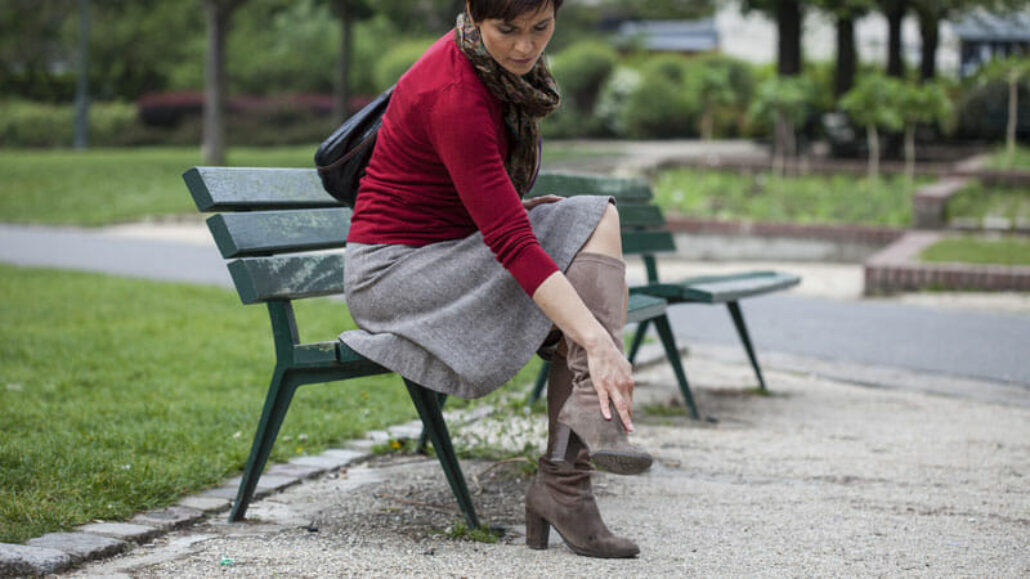Learn about the symptoms that distinguish a ganglion cyst from a foot cancer.
When a painful bump appears on your toe joint or the bottom of your foot, it can be unsettling. However, more often than not, what you are experiencing is a ganglion cyst. Foot and ankle specialist Dr. Michael Anderson explains how these uncomfortable cysts develop and discusses treatment options.
What is a ganglion cyst?
“These cysts are small benign pouches of fluid that form around a joint or tendon sheath,” says Dr. Anderson. “They form when a hole or tear develops in the joint capsule or the sheath, allowing joint fluid to escape. The hole becomes a one-way valve for escaping fluid. As the fluid continues to escape, your body walls the fluid off and encapsulates it. They tend to develop slowly over time. If the cyst is small, you may not even notice it. However, in some cases, the cyst gets large enough to become painful. It may rub inside the shoe or limit the types of shoes you can wear. That pain is usually what triggers someone to come in and have the cyst evaluated.”
How do you distinguish cysts from foot cancer?
Whenever a mass appears on the body, it’s understandable that people are concerned about cancer. Dr. Anderson is quick to offer reassurance. “Soft tissue cancer in the foot and ankle is very rare,” he says. “I’ve seen only one case of soft tissue foot cancer so far in my medical career. If you discover a lump, it’s always good to get it checked out. But the chances that a bump on your foot is cancer are very low.” Dr. Anderson reviews several factors that distinguish foot cancer from a ganglion cyst.
- “Soft tissue cancers tend to hurt quite a lot,” he says. “By comparison, you may have a ganglion cyst that never causes pain, or that only causes pain when it is large enough to interfere with your footwear.”
- Cancerous masses are often hard, firm, and not very pliable. By contrast, cysts are usually softer and pliable.
- “A cancerous lump feels as though it’s fixed in place,” says Dr. Anderson. “On the other hand, a ganglion cyst is mobile and pliable to the touch. It will move around under the skin.”
- “The cancer I saw was around the ankle,” says Dr. Anderson. “Typically, that’s not where ganglion cysts occur. I find ganglion cysts around the joints of the big toe, the cuboid lateral foot, and the dorsal foot. It’s more unusual to find them around the ankle joint.”
- Growth rate. Cancers can come on quickly and expand rapidly in size. With a ganglion cyst, you may not even notice it for quite a while. And when you do, it will probably stay consistent in size, or grow slowly.
Risk factors for ganglion cysts
There are a number of factors that increase the risk of developing these cysts.
- Sex and age. Ganglion cysts can develop in anyone, but they are most frequent in women between the ages of 20 and 40.
- Foot joints, as well as hand joints, subject to the wear and tear of arthritis are at higher risk.
- Joint or tendon injury. Past joint injuries make feet, or hands, more susceptible to ganglion cysts.
“Unfortunately, none of these factors are particularly modifiable,” notes Dr. Anderson. If you have any of these conditions and then find a bump, it’s likely that it will be a cyst. These risk factors correlate with the likelihood that a cyst will occur.”
Diagnosing ganglion cysts
Imaging is not always necessary to diagnose these cysts. “Usually,” says Dr. Anderson, “I can identify a cyst based on an exam and the patient’s medical history. However, in cases where the mass is particularly painful, shows up in an atypical area, or is growing quickly, we definitely need advanced imaging. Also, if we are considering surgery, advanced imaging is helpful for presurgical planning. Finally, there are patients who request an MRI for reassurance. If it makes someone feel better to evaluate the cyst with an MRI, I’m happy to do that for them.”
Treatment options for a ganglion cyst
“There are three options for people with these cysts,” says Dr. Anderson.
- Do nothing. Without treatment, cysts will continue or worsen. “It’s unlikely that these cysts will go away on their own,” says Dr. Anderson. “But you don’t have to treat these cysts. In fact, I don’t recommend treatment unless the cyst is bothersome or is interfering with shoe wear or activity.”
- A foot specialist can aspirate the cyst, using a needle to draw the fluid out of the cyst and collapse it. “I don’t usually recommend an aspiration,” says Dr. Anderson. “However, sometimes a patient has an event or trip coming up, and wants a cyst aspirated for temporary cosmetic or comfort reasons. In those cases, I’ll aspirate the cyst for them.”
- “When cysts are painful or bothersome, I do recommend removing them surgically,” says Dr. Anderson. “However, it’s important for patients to understand that even with accurate and successful surgery, these cysts can recur. Data about surgical outcomes indicate that one in every five removed cysts will regenerate following surgery. This is because an individual’s tendons or joint may be predisposed to developing holes. We can fix an existing hole, but we can’t prevent weak tendons or joint capsules from tearing again and reforming a cyst.”
Summit Orthopedics offers personalized foot and ankle expertise
Our fellowship-trained foot and ankle physicians understand that your mobility depends on the health of your feet and ankles. If you have suffered an injury or are experiencing symptoms that make walking painful, our team of foot and ankle specialists can help with conservative treatment; proven, evidence-based surgical options; and expert rehabilitation support. Summit Orthopedics specialists have the expertise to evaluate your discomfort and develop a plan to quickly and safely get you back on your feet and on your way.
Start your journey to optimal foot health. Find your foot and ankle expert, request an appointment online, or call us at (651) 968–5201 to schedule a consultation.
Summit has convenient locations across the Minneapolis-St. Paul metro area, serving Minnesota and western Wisconsin. We have state-of-the-art centers for comprehensive orthopedic care in Eagan, MN, Plymouth, MN, Vadnais Heights, MN, and Woodbury, MN, as well as additional community clinics throughout the metro and southern Minnesota.

